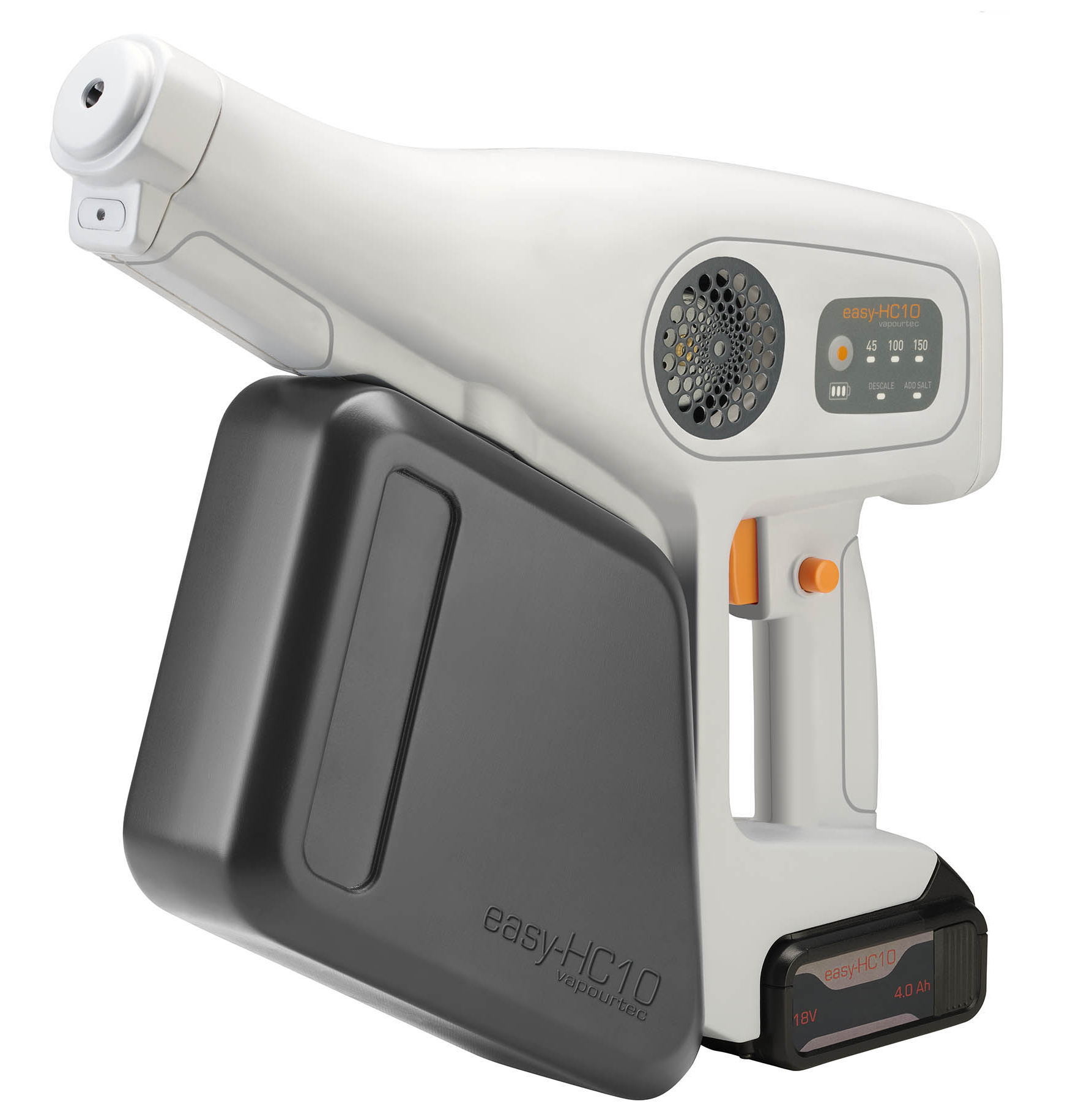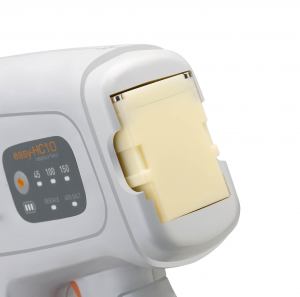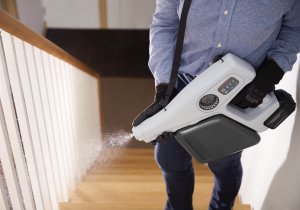
Date: 15 April 2021 | Category: Headline News, News
*Patent Pending
The easy-HC10 is a unique cleaning and disinfectant maker sprayer. An electrochemical flow reactor instantly converts salt water into a high-quality antiviral disinfectant (hypochlorous acid) before dispensing in a fine mist to disinfect surfaces in public areas.
There is no doubt Coronavirus has changed our lives. The loss of relatives and the restrictions on our freedoms, in order to curb the spread of the virus, have not been easy. COVID-19 has reshaped the way we do things with some of these restrictions set to be part of our lives in the months and years to come.
From the beginning of the pandemic outbreak the Vapourtec team has aimed to contribute to the fight against the virus in as many ways as possible. We have been developing several in-house projects and closely supporting customers working on COVID-19 related projects.
It was clear from the start of the outbreak that the disinfection of public spaces and working areas would be key to keeping businesses running and ensuring everyone’s safety. Existing disinfectant sprayer and cleaning products are both expensive to run and not eco-friendly. The easy-HC10 disinfectant sprayer is a pioneer in these regards. With a sometimes-rudimentary design, existing disinfectant sprayers are simply sprayers of chemical biocides, such as hypochlorous acids, usually bought in bulk.
Hypochlorous acid (HClO):
Hypochlorous acid (HClO) is probably the best suited biocide for this application. It kills viruses, is food safe, and leaves no harmful residues when it degrades. Unfortunately, HClO is not very stable and does not store well. With a shelf life of days [1] and, prone to light degradation in matter minutes [2], HClO solutions need to be kept cool in opaque containers just to be stable for few weeks. Using stock solutions of HClO can be more expensive and problematic than one would think.
Without knowledge of the date of manufacture, nature of storage or how long it has been in transit, the concentration of HCI0 stated on labelling is merely an indication of the initial concentration. Unless solutions are tested prior to every use, it is not known whether it’s water, HClO with 3 ppm or 150 ppm of free chlorine being sprayed.
As an innovative technology company and pioneer in the field of flow chemistry, Vapourtec does things differently. We recognised that the process of manufacturing HCIO could be improved by doing it in flow, as a disinfectant sprayer. Theoretically, with the right set-up, we could continuously electro-oxidise chloride ions (from salt) into hypochlorous acid as confirmed by the equations below:
2Cl– – 2e– → Cl2
Cl2 + H2O → HClO + H+ + Cl–
If we were capable of doing it with a portable battery-powered device, we would KNOW the precise concentration of HClO being sprayed at any given moment. It means no more expensive solutions of an unknown strength, no more transportation requirements and no containment of chemicals. Just open a tap, fill the reservoir, add salt, shake, and spray high quality HClO.

With this in mind, we began with the development of the right conditions using the Vapourtec Ion electrochemical reactor. Sodium chloride was ideal, as it acted as both electrolyte and source material. With a wide variety of electrode materials available for the Ion, we evaluated them, against residence times, salt concentration and electric current.
Design, development
With the optimum conditions, we turned our eyes to the design and development of a portable version of this electrochemical flow cell. The challenges involved the cells being impervious to salt water and electrons, were low cost and worked consistently for more than 1,000 litres. Once our crude prototype, handheld flow system could generate HClO having 150 ppm free chlorine and spraying the HClO as fine droplets, we started working on the final product design. It needed to be ergonomic, battery powered and easy to use; a simple task compared with solving the materials science behind the continuous flow electrochemical cell.
We designed the cell to be removable. The resulting product is the easy-HC10, named in tribute to the chemistry involved and features a control panel to select the concentration of HClO; 45 ppm free chlorine for food contact, 100 ppm for everyday use and 150 ppm for deep cleaning. With a reservoir of 2 litres and a battery life of 1.5 hours, more than 8 litres of HClO can be manufactured and sprayed with one charge with the disinfectant sprayer.
 The design of the easy-HC10 disinfectant sprayer is now complete and the tooling for the plastic injection mouldings is being manufactured. Product approvals will be achieved during July 2021 when we will make our first deliveries of this innovative flow chemistry product.
The design of the easy-HC10 disinfectant sprayer is now complete and the tooling for the plastic injection mouldings is being manufactured. Product approvals will be achieved during July 2021 when we will make our first deliveries of this innovative flow chemistry product.
Duncan Guthrie, Vapourtec’s M.D, commented: “I am very pleased to share such a revolutionary product. The world needs new solutions so we can return to normal life. Our company was probably one of the best suited to take on this challenge. With an immense technical expertise in science, flow chemistry and product design, we created a product that generates HClO in-situ, so that customers can be certain that it disinfects both efficiently and effectively. The easy-HC10 disinfectant sprayer is not only dependable, eco-friendly and convenient but also far more cost effective than existing disinfection products on the market.”
References
[1] G. Rossi-Fedele, E. J. Dogramaci, L. Steier, and J. A. P. de Figueiredo, “Some factors influencing the stability of Sterilox®, a super-oxidised water,” Br. Dent. J., vol. 210, no. 12, pp. E23–E23, 2011, doi: 10.1038/sj.bdj.2011.143.
[2] L. H. Nowell and J. Hoigné, “Photolysis of aqueous chlorine at sunlight and ultraviolet wavelengths—I. Degradation rates,” Water Res., vol. 26, no. 5, pp. 593–598, 1992, doi: https://doi.org/10.1016/0043-1354(92)90232-S.
